#a little palais garnier history!
Text

this is the center dome of palais garnier. today it's used as a rehearsal room, but in the rewrite's time...

it was a chandelier space! it used to be raised up there for cleaning

until the infamous incident that is! ;)
the space is now used for rehearsals and the chandelier has been lowered ever since!
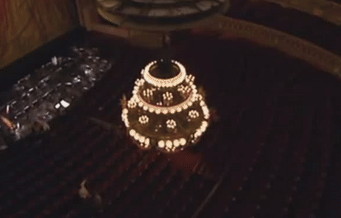
#a little palais garnier history!#and a resource for the big scene i'm writing! ;)#i can't find a high quality pic of the old dome which isn't great for causing chaos#but at least i have an ok idea!#it looks like it might be a cherik situation... ;)
218 notes
·
View notes
Text
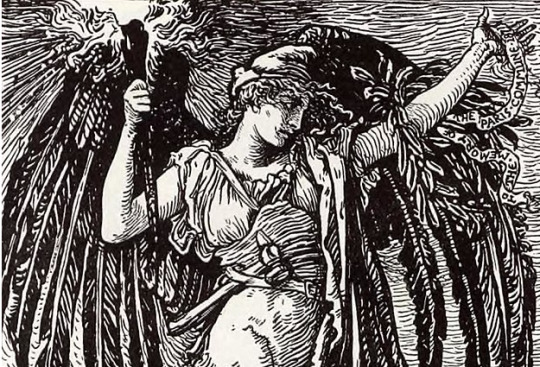
May 21 through 28 is the anniversary of the end of the 1871 Paris Commune.
For the last three years, I've promoted a Commune Week for the Phantom of the Opera fandom as the Commune and the anarchic terrorists that came after played a role the inspiration for Leroux's novel.
There was no call for Commune Week this year but I do encourage everyone to look through the #poto paris commune 1871 tag and take a look at the fic that was written over the last few years. For those fans who enjoy the history of the Phantom of the Opera and Gaston Leroux's career as a journalist, enjoy. For those who participated in the event previously, reblog your work!
The Commune is still relevant today though little discussed in English language media. Above all, your take away should be that the Palais Garnier was never a prison and that nobody would have ever thought that skeleton was a victim of the Commune.
Image by Walter Crane
8 notes
·
View notes
Text
Okay so in my Art of Theater class, we were each asked to do a presentation on a topic of our choice relating to theater, and the topic I chose was opera, as a form of theater. I presented it in late March, it ended up being rather successful, and my teacher liked it well enough to ask me to present it to her other section of that same course, which I did. And so today I had my final exam for this course, so this inspired me to post the slides of my presentation (well, I already had this idea on the day of the presentation, but it’s a convo with @smile-at-the-stars yesterday that truly motivated me to work on it), alongside an approximation of the extra stuff I said orally while presenting.
(Note: the star-shaped bullet points are actually gold-colored, for some reason, when I converted the slides into either JPEG or PNG format, they keep getting colored white. I have no idea why.)

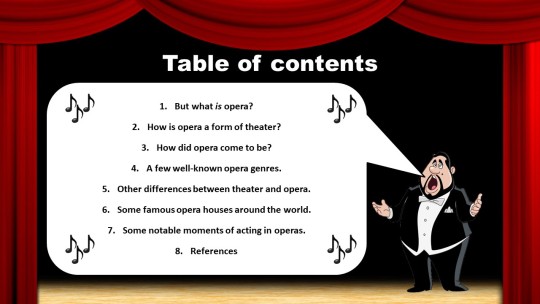
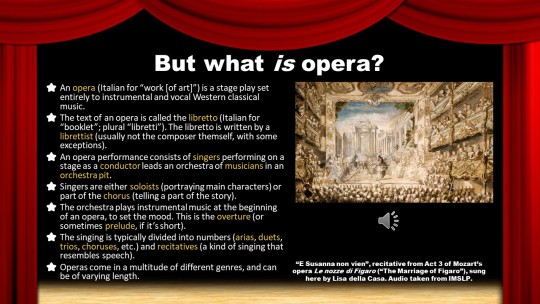
“When I say ‘opera’, you may think of a singer standing on a stage and singing in a style some of you might find weird or even unpleasant. Yeah, that’s not opera. That’s just singing. Lyrical singing, or classical singing, or whatever you want to call it. Opera specifically is when this type of singing is placed within a theatrical context.”
(To show the difference between an aria and a recitative, I sang the first 8 measures of Vedrai, carino, and used this audio, which I cut at around 0:32)

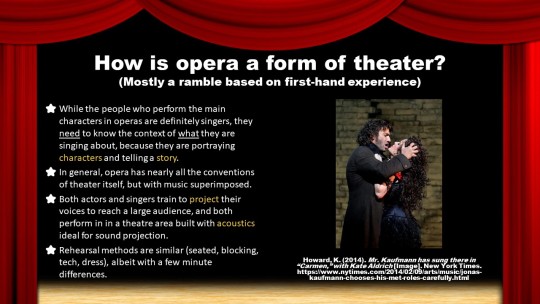
Here, I emphasized why I highlighted the word “acting” in the grid above, and also explained that opera students at my Conservatory are given the basics of Italian and German, in order to better understand what they are singing about.
As an example of how singers have to properly convey the emotions of the character they are portraying as they sing, I mentioned an anecdote about the time I was practicing L’ho perduta, which is about a young girl who lost an object and is desperately searching for it, and my voice teacher told me something like: “do not sing it in a grand manner, you are not La Contessa with a big voice. You are this little girl who is desperately searching for that pin she lost”. In order to show the difference to the students, I sang the first couple lines of L’ho perduta in a somewhat grand way, and then I sang it again in a more subdued way that better reflects the context.
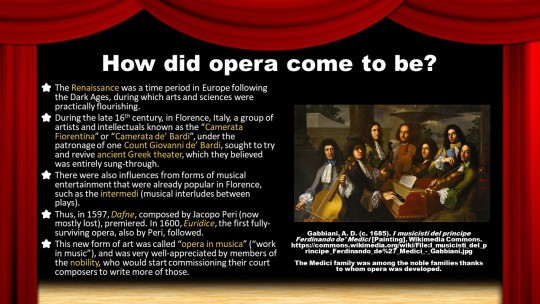
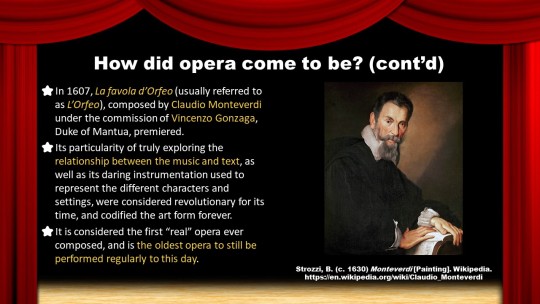
(I mentioned that in L’Orfeo, the living world is represented by string instruments while the Underworld is represented by brass instruments, but that’s not very important.)
I also added that even in upcoming opera season announcements all over the world that had come out recently, you can find L’Orfeo in quite a few of them.

“I’m gonna stop here, because otherwise this would take WAY too long. I highly recommend you read more about the history of opera.”

To give the others a better idea of what I mean by “vocal virtuosity”, I briefly sang the first 2 measures of Lütgen’s Etude No. 8 (the clarinet part; up till 0:05).
My commentary on Barber of Seville: “This is the opera that ‘FIGARO, FIGARO, FIGARO’ comes from”. And Lucia di Lammermoor: “You might recognize some of the music from it if you’ve watched The Fifth Element, the scene with the alien singing opera”.
I described Wagner’s operas as having “MASSIVE orchestrations, requiring HUGE voices, lasting like 4 hours”.
I mentioned that Bohème is one of my favorite operas, and that it’s the opera that RENT was based on.
I explained that operetta tends to contain spoken dialogue.
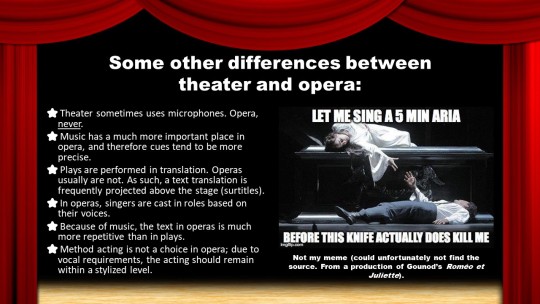
“If you mention microphones in the opera circles on social media (e.g. Reddit), you will be sure to start a war” (it’s kind of an exaggeration, but 😝).
“You cannot cry while singing, because it messes your vocal cords.”
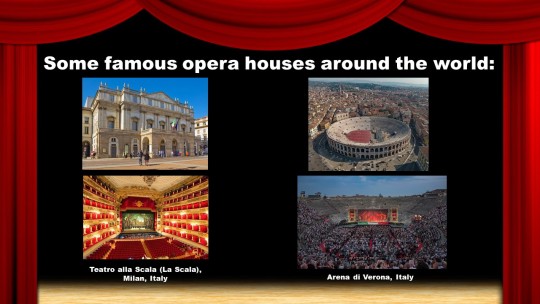
“I chose these two opera houses to show you the difference between a proscenium stage (the format of most opera houses around the world, just like theatres) and an arena, as we learned some time ago during this course.”
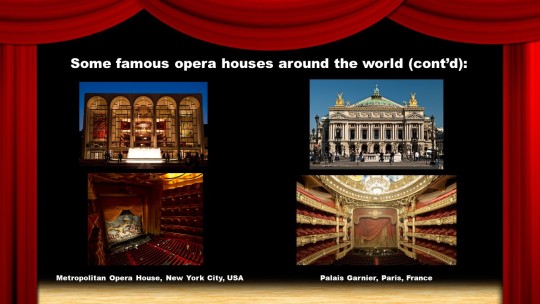
Palais Garnier: “which is where the Phantom of the Opera lives”.

The Sydney Opera House “is much more well-known for its exterior than its interior, but it actually houses several venues. The main venue is just concert hall, but the one in the picture here (the Joan Sutherland Theatre) is where operas are typically performed”.
The Bayreuth Festspielhaus: “which performs exclusively works by Wagner. I chose to show you this one because it has a bit of an unusual structure; it rather resembles the thrust stage format, and the orchestra pit is located kind of under the stage”.
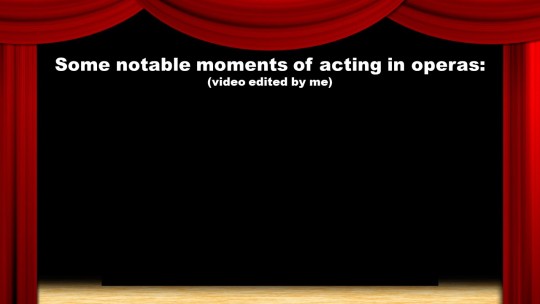
The video in question (subs by Yours Truly, except the ones in the last footage, which were already there, when I downloaded it from the Met’s channel).
The following week iirc, the teacher mentioned Diana Damrau’s Queen of the Night as one example of stylized makeup, as opposed to realistic makeup, and I added that it’s because that opera is a fairy tale opera or sorts.
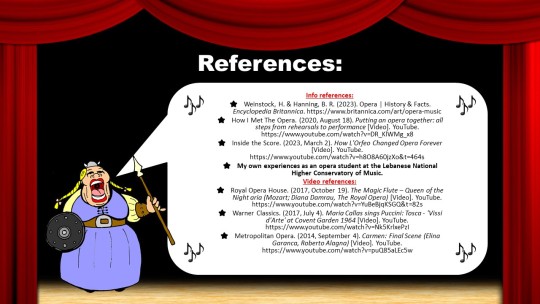

18 notes
·
View notes
Note
💻 ⏰🖊️ please!
💻Do you do research for your fics? What's the deepest dive you've done?
Yup, big time. I like to know the details, down to the plans of the space my characters walk, even if those things never make it onto the page. I'm currently researching a bit of the history of Romans in Scotland, and ancient Greek sacrificial rituals (that's made my algorithms interesting 😆) for the fic that I'm working on at this moment. I still have the plans and photos and files of research that I did on the Palais Garnier for Coryphee, including a little info on the company that tendered for the security contract.
The deepest dive I've done, though, was for Stars and Fire, a fic I wrote in the Fushigi Yuugi fandom. I ended up teaching myself a little (very little) Chinese, looking into papers on the border forestation policy of the Sung dynasty, and deep diving into the construction, history and crewing of Chinese ships, and dipped heavily into Chinese and Japanese cosmology and astronomy, among other things. It was fascinating, and I have volumes of notes.
None of this is to say that I always get everything right, and at the end of the day I'm writing fiction, but the research wonk in me has a good time.
⏰ Do you spend more time reading fic, writing fic, or do you do both equally?
I think it winds up being roughly equal, although some days it leans more one way or the other, depending on whether my writing is coming together or not, and sometimes whether there's a lot of new stuff posted.
🖋 Post a snippet from a current wip
Okay, here's a bit of what I'm working on right now 😁 This is the fic sparked by a discussion about a prompt - ‘You have been kidnapped by a cult preparing to sacrifice you to their god. However, you are immortal, the god they worship is a close friend of yours, and the entire cult was a prank you pulled…’ and then @verfound suggested that the 'sacrifice' might be a bit of immortal roleplay to spice up their love life, and this plunny grabbed me by the throat:
“I worked so hard on all of this,” she sighed, waving a hand to take in the altar, her gown and the stone mural behind her, along with the flowers artfully wound around the pillars. “And it’s all ruined.”
“Oh, I don’t know. We have the temple all to ourselves now, and I spent far too long trying to explain to your followers how to tie these ropes. It seems a shame to waste all that effort,” he said provocatively. He backed her up slowly until she could feel the edge of the stone table against her knees through the bunched layers of her satin skirts.
He glanced up at the altar with its flame burning brightly, and his devilish grin softened into something sweeter as he read the Latin inscription.
“That was the first song I ever wrote you,” he said reminiscently.
“It’s still my favourite.”
8 notes
·
View notes
Text

@firstsorrow’s Christine gets a starter from Hela!
———
La Palais Garnier.
It was the next stop on her class’ European tour and one of Hela’s most anticipated. Though she knew very little of mortal opera, she did have fond memories of watching Asgardian theater as a child. It had instilled in her an appreciation for the arts, a fondness even.
She followed her class as they moved through the building listening to a woman as she recounted the history of the architecture until something else piqued her interest - a subtle feeling. Coming to an instant pause, she let people pass her by, emerald gaze searching. If anyone even noticed her, they only spared her a glance and since Peter had snuck off (again), she eventually found herself alone in a hall of dressing rooms.
Following a new path, Hela continued to one particular one where she finds what she first sensed - another lost soul left to wander. It wasn’t the first ghost she had encountered while on Midgard and it certainly would not be the last.

1 note
·
View note
Text
Tenth Week
Hi, my name is Robert Laskarzewski, and I am currently a sophomore at the Darla Moore School of Business studying International Business and Marketing. I’m a part of the International Business Responsible International Leadership (RIL) program and will spend the Spring and Fall semesters at the ESSEC Cergy campus. I was born and raised in California, about an hour away from San Francisco. I chose to attend the University of South Carolina specifically because of the RIL program and the amount of time abroad that was offered. Once I was accepted, it was an easy choice to choose to pursue my studies there.
On Thursday I have both of my French classes, one being a French language class and the other being about French culture and history. This week I had my French language mid term (which went well as far as I know) and – more excitingly – a field trip for my French culture class. We all met up in Paris next to the Palais Garnier where our professor gave us a brief lecture on the history of the area. After this, we visited the Museum of Perfume which is run by Fragonard, a traditional French perfume company that doesn’t export any of its products and spends no money on advertising. After this we passed through the Tuileries Garden where the group fragmented with some returning home to Cergy and others spending more time in Paris.
On Saturday, I went to the museum of hunting and nature, the national archives, and the Cognacq-Jay Museum. Initially, I had no plan to go to any of these places but seeing as I had nothing else to do on this day, I decided to go to some museums I hadn’t yet been to. It was a cool, cloudy day in Paris, but the sky was still nice and bright, making it a good day to go into the city.
I took the RER A train to Chatelet, and from there I took one of the metros to get a little bit closer. The hunting museum is in an area of Paris that I’m not too familiar with, so it was nice to broaden my awareness of Paris and its different districts (or arrondissements). I had to pay 8 Euro to get into the museum as it is privately owned and run. The museum itself is founded by Francois and Jaqueline Sommer, a couple who were avid hunters and equally passionate about the preservation and conservation of nature. Although I am a bit opposed to trophy hunting and the room showcasing this, I enjoyed the museum as it showed off the history of mankind’s relationship with the natural world throughout history and its significance as such.
After the hunting museum, I visited the National Archives where I received free admission as it is a public museum. I didn’t know where to see the most important documents (I assume that I missed them) however, I did see documents from Marie-Antoinette and some other famous figures from French history. The building was very pretty and had a very interesting history (that I learned from via a movie room where there was a short documentary about the history of the building). I stumbled upon the Cognacq-Jay Museum after the National Archives where I (also) received free entry. Although the art wasn’t extremely impressive to me, I enjoyed the building and the courtyard that the building encircled. This museum is part of the 14 City of Paris Museums (of which I have only been to one other), so now I’ll have to visit the rest of the lot.


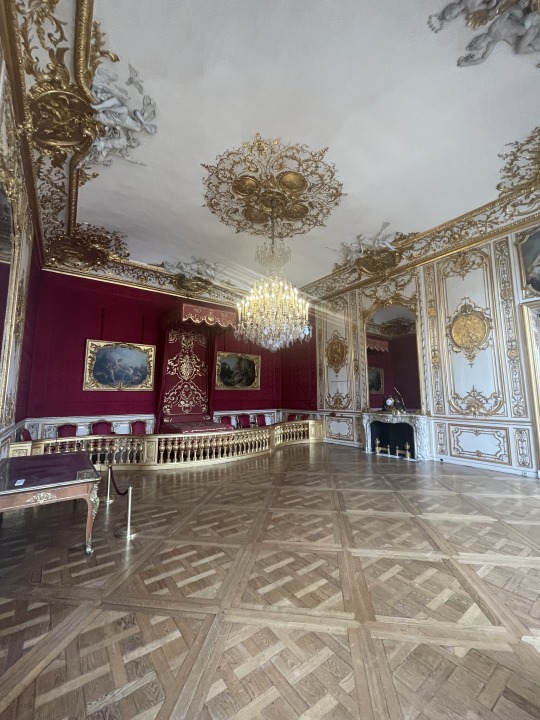

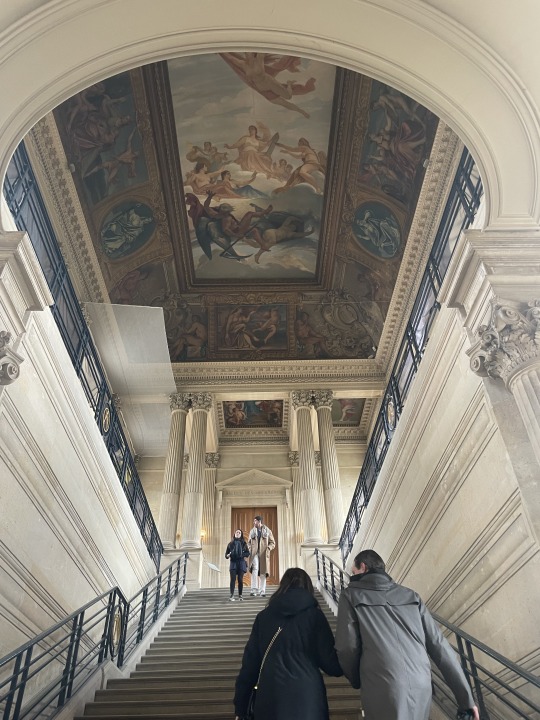
0 notes
Text
Europe 2022 - Paris
Due to airport, traffic, hotel, and navigation difficulties, I did not get to start my sightseeing until late Friday afternoon. By the time I found the hop and off bus, it had only 3/4 of the route left before it stopped for the evening. So I made the best of it and checked out some famous Parisienne landmarks from the top of the bus - Eiffel Tower, Arc de Triomphe, & Champs-Élysées. When it ended, I took the Metro back to my hotel, stopping for a chocolate eclaire on the way. Once back at the hotel, I headed for supper (chicken skewers with salad and a strawberry mojito). Early bed as I had a little jet lag.
The next morning I woke up later than expected, ate breakfast at the hotel and headed via Metro to Île de la Cité to see Sainte Chapelle. I was told by friends that this was a must see and it didn’t disappoint. Sainte Chapelle is famous for its 15 stained glass windows, each 15 metres high, the glass panes depict 1,113 scenes from the Old and New Testaments recounting the history of the world until the arrival of the relics in Paris. Amazing. As I was already on the Île de la Cité (tiny island community on the Seine), I walked around and headed past Notre Dame Cathedral to get a better look. You couldn’t go in as they are still restoring the church from the devastating fire in 2019. I then headed over to Île Saint-Louis for their famous gelato at Berthillon (pistachio in case you were wondering). I headed back across to see the Mémorial des Martyrs de la Déportation. A memorial to the 200,000 people who were deported from Vichy France to the Nazi concentration camps during World War II, located under Notre Dame Cathedral. I walked over to the bus stop and boarded the hop & off bus again. I took some more photos from the top deck while heading to the Arc de Triomphe. I got off the bus to climb to the top to see excellent panoramic views of the city and the twelve streets that converge in the square. It was 193+37+46 stairs, plus then up down and up the 37+46 again before heading all the way down.
After waiting for three full buses to get a seat in another bus, I continued on to the Champs de Mer for a great selfie view of the Eiffel Tour. Then back on the bus to the Palais Garnier (Paris Opera House). I had to see inside the famous opera house, so I booked a self guided tour. As I am walking through I am picturing the Phantom of the Opera playing out in my head. I got back on the bus and headed to the Louvre for some outside shots (no time to go into the largest museum in the world). I got back on the bus again, and almost did the route all over again to get back to the Eiffel Tour (I might have had a nap also). Once at the Eiffel tour I boarded the Bateaux Parisiens for a trip down the Seine. Unfortunately the clouds opened up and rained poured down for the rest of the night).
Once off the ship, I headed back to my hotel. I stopped for French pastries on the way for a late supper. It was an exciting 36 hour sojourn in Paris, now off to Amsterdam in the morning!

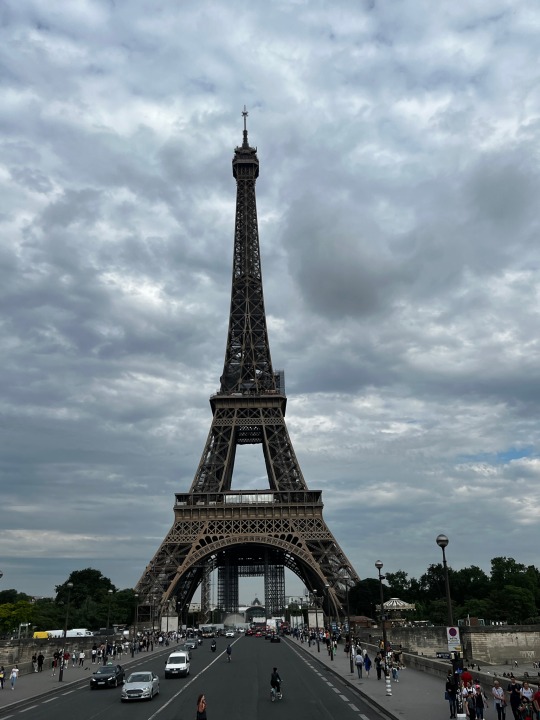


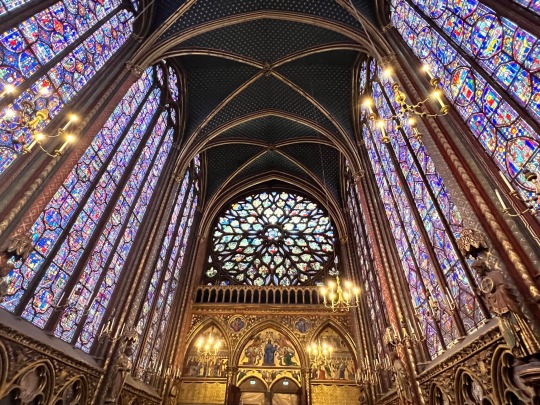
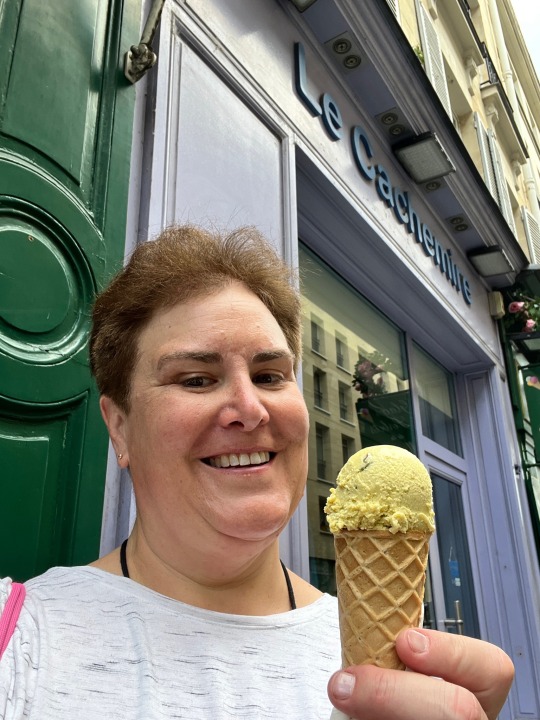
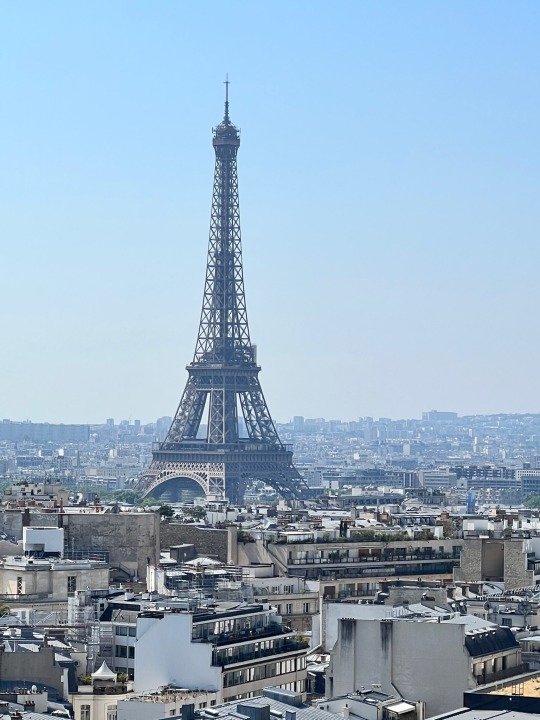

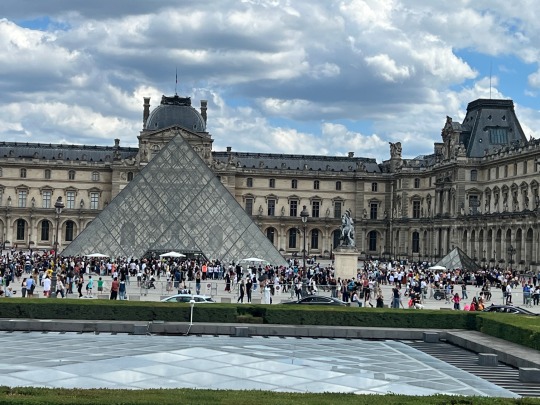

1 note
·
View note
Text
Notes on Gaston Leroux‘s „The Phantom of the Opera“ - Epilogue
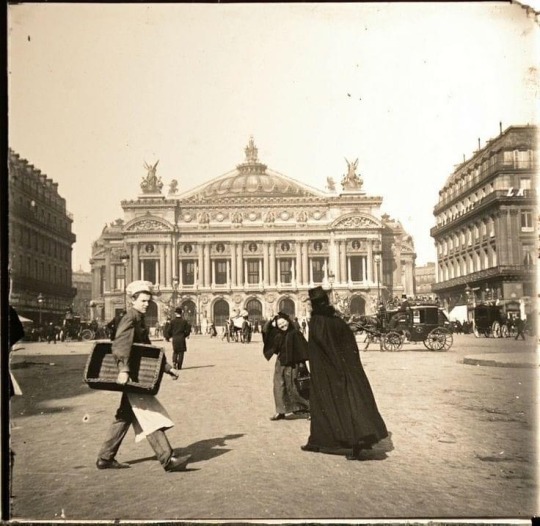
<< Previous chapter
“It is a far, far better thing that I do, than I have ever done; it is a far, far better rest that I go to than I have ever known”
-Charles Dickens, “A Tale of Two Cities”
As we are coming to the end of the story, Leroux ties up a few more loose ends in the epilogue.
As for Raoul and Christine, their possible happy ending is only implied by what Erik told the Persian - that they had “taken a northbound train” and were planning to get married in secret. They have disappeared from the world, and Christine never appeared again on stage anywhere. According to Leroux, they might have finally settled in Norway together with Mama Valerius. At first, I thought Leroux might have been confusing Sweden and Norway, but when I did a little research on the name „Daae“, it turns out that the name is actually most prevalent in Norway, with almost no occurrences in Sweden. It is also implied that even if they took that “northbound” train before, Christine took a train back to Paris a few weeks later to return to Erik, because she had the wedding ring on her when she left, and it was finally found on Erik‘s finger.
As Philippe‘s death was deemed to be the consequence of the fight between the two brothers over Raoul’s supposed engagement to Christine, Raoul was a murder suspect - but as his previous testimony had already made him appear a lunatic in the eyes of the Commissary, Philippe‘s death was ultimately pronounced accidental. However, as Parisian society had taken less than kindly to the news of the engagement, I think that the couple would have had a very difficult standing if they had officially married and assumed the now vacant titles of the Count and Countess de Chagny. It is therefore likely that Raoul, having officially disappeared, never claimed his titles and inheritance, and chose the more simple lifestyle that Christine was accustomed to. Leroux concludes the story of Raoul and Christine with the statement that one day, he too might „hear the solitary echoes of the Northland repeat the singing of the woman who knew the Angel of Music''. In the epilogue, the boundaries between the „false“ and the „real“ Angel of Music become blurred, as Leroux repeatedly speaks of Erik as the “Angel of Music” - indicating that maybe, just maybe, Erik truly was the Angel of Music.
After following up on Raoul and Christine, Leroux relates how he obtained proof of Erik‘s existence from the Persian, mostly through the letters written by Christine that Erik had sent to him, but also through the testimonies of Meg Giry and La Sorelli. He supposedly placed all the proof he had gathered in the archives of the Paris Opera.
He also obtained the testimony of M. Poligny, the previous manager of the Opera. The „Opera Ghost“ affair was the final straw that made him resign his post, which again indicates that Erik‘s reign as „O.G.“ was rather short and caused by Erik falling in love (since he had been living in the Opera House presumably since the early 1870s). He also quotes from the fictional „Memoirs of a Manager“ by Armand Moncharmin, where Moncharmin relates that a few days after Christine‘s abduction, Erik returned all of the forty thousand francs he had extracted to the managers, no longer having any need for the money as he had given up his plan to marry Christine. The mystery of the safety-pin is also finally resolved, as Leroux was supposedly able to locate a small trapdoor in the floor of the managers’ office, through which a dexterous magician like Erik could easily have reached up and retrieved the envelope from Richard‘s coattail pocket as it was hanging down from his chair.
Leroux also notes that the marble pillar next to Box 5 sounds hollow and would offer ample space for Erik to hide inside it. According to Gérard Fontaine’s research, the pillars being hollow applies to all the pillars in the auditorium of the Palais Garnier. Whether that proves or disproves anything is up to you... Leroux’s plan of having the lake drained in order to obtain the ultimate proof of Erik‘s existence - finding the entrance to the house by the lake - did not go through, but Leroux still sustains his hope of one day finding the score of „Don Juan Triumphant“ there (that is, if Christine had not taken it with her when she came to bury him).
Leroux then gives a summary of Erik’s life according to the Persian. Erik was born near Rouen in France and ran away from his parents as a young boy, as they were afraid and horrified by how he looked. After being exhibited as a “living corpse” at fairs, he became a singing sensation and garnered a reputation that reached as far as Persia. The daroga of Mazenderan was sent to bring Erik to Persia as entertainment for the “little sultana”. Erik, who also worked there as an assassin, is described here as amoral, “not knowing the difference between right and wrong”. Even though he does not have an evil heart, his life up until this point has left him completely without a moral compass of any kind.
After building an ingenious palace for the shah, Erik’s execution was ordered so that he could not divulge its secrets to anyone. The daroga was supposed to carry it out, but as he owed Erik favours (and was the one who brough Erik to Persia in the first place), he helped him escape instead. He was punished for this and went into exile to Paris. Erik took a detour to Asia Minor and Constantinople before he ended up in Paris as well. It is also mentioned that Erik could make lifelike automata, which is reflected in the musical in the form of the monkey music box and also the “mirror bride”, a physical representation of Erik’s dream of a loving wife.
Once in Paris, Erik decided that he finally wanted to live a normal life, and placed a successful bid to work as a contractor on the Opera House. Wishing to hide his face from the world forever, he built his comfortable home into the foundations of the Opera. Erik’s plan to live out the rest of his life in peaceful tranquillity went well - until he crossed paths with Christine Daae and lost his heart to her completely. And the rest is history…
Leroux here gives his own view of Erik: “He had a heart great enough to hold the empire of the world, and in the end he had to be content with a cellar.” With a normal face, Erik, with his brilliant mind and extraordinary talents, could have had the world at his feet. And even though no one had ever loved him, he still had a heart capable of feeling deep, pure love, which is pretty remarkable. His beautiful voice is a reflection of the beauty he carries inside his soul - which was sadly eclipsed by his ugliness, which did not allow him to live “like everyone else”. The great tragedy of his life was his face, which kept others from treating him as a human being and recognizing his full potential. He is therefore clearly worthy of pity, instead of being cursed and condemned as evil.
Leroux had already mentioned in the Prologue that he believed the skeleton found in the cellars of the Opera was Erik’s. Now he finally reveals why he was so certain of that: because Erik’s skeleton wore the gold wedding ring on his finger, which Leroux believes Christine had placed there. Even though Erik had set her free and given her the ring, she later came back to him, and this time it was certainly not out of terror. With Erik dead, none of his threats would hold any more sway over her - and yet, she still returned to him to keep her promise. She not only buried him with the wedding ring, but she slipped it onto his finger, ultimately fulfilling her promise to accept him as her husband. In a sense, she buried him with her love, and that is truly a bittersweet and beautiful ending. After everything he had to endure, Erik’s life ends with a kiss and a ring on his finger, put there by the woman he loved more than his own life, and with Leroux praying for his salvation. That may not be a traditional happy ending, but it‘s very powerful. And it’s definitely not a villain’s ending.
As „Faust“ is the most strongly referenced work in „Phantom“, it is also worth comparing how the endings are different. In the final act of Gounod‘s opera, Faust and Marguerite first swear their love to each other, but when Marguerite sees Mephistopheles and realizes who Faust really is, she turns away from him and chooses death instead, while Faust is dragged into the fires of hell. Her famous last words to him are „You horrify me!“ In „Phantom“, the progression is almost the other way round - Christine is horrified at first, but then accepts Erik and chooses life instead of death.
It should also be noted that the ending in the novel is so vague that it also allows a lot of room for the reader’s imagination. Was Erik really dead when Christine returned? He himself was announcing his death, so it would not even be so very unlikely. But as this is Leroux’s story, the official reading would of course be how he himself imagined the ending: Erik dying and Christine coming back to bury him. This might be my favourite line from the novel:
“The skeleton lay near the little fountain, where the Angel of Music first held the unconscious Christine Daae in his trembling arms after taking her into the cellars of the Opera.”
As if the return of the ring was not enough poetic closure, he also asked to be buried in the very spot where he held the love of his life for the first time...
Symbolism and Metaphors
Now that we have concluded the epilogue, I would like to add a few more notes on the general themes which are present throughout the novel and still influence how we feel about it today.
To understand the extent of symbolism employed in „The Phantom of the Opera“, it is necessary to understand the cultural mindset and environment in which it was written. At the turn of the century, the arts (and sciences, as evidenced by the slowly emerging works of Sigmund Freud) were rather obsessed with the fateful connection between Eros and Thanatos - love as the life-bringing force, and death as the destructive force. Both were often seen as intertwined and mirrored in the other.
Erik is the personification of Eros and Thanatos. He unites both forces in him to a degree unparalleled by any other character in the story. The death symbolism that is also clearly reflected in how he is described, would be both perceived as horrifying - and yet not without a strangely seductive fascination inherent in it. Death is intricately tied to darker feelings of passion and desire.The “Eros” and the “Thanatos” part of his character are intertwined, but his character also oscillates between the two sides in the course of the story.
Music in „Phantom“ also serves as a metaphor for romantic love, not only in the spiritual but also in the physical sense, as it is connotated with “passion”, “fire”, “ecstasy” and “rapture” throughout the story. Erik’s teaching awakens “an ardent, voracious and sublime life” in Christine, symbolizing the burgeoning romantic feelings in the young woman. She is terrified with the changes going on in her, which is also in line with how „Eros“ was originally viewed: as a frightening loss of control. Erik says in “Apollo’s Lyre” that “some music is so formidable that it consumes everyone who approaches it”, and Christine states that “Music has the power to abolish everything in the outside world except its sounds, which go straight to the heart”. In both sentences, the word “music” can easily be replaced with “love” - especially in Christine’s example, it would be the musical equivalent of “love is blind”.
Like in other (gothic) romances - “Wuthering Heights” being perhaps the prime example - the two rivals in the principal love triangle represent two very different types of love: one is intense and passionate, but also consuming, terrifying and potentially destructive, and the other is safer, but also somewhat chaste and lifeless. Erik and Raoul each represent one of the two extremes. This contrast is exemplified in the scene at the Masked Ball: Raoul wears white, the colour of innocence, while Erik wears red, the colour of passion, but also of danger and blood.
It is suggested in the novel that Erik and Christine were chained together by fate (“La destinée m’enchaîne à toi sans retour”), and I believe they were destined to save each other. Erik saved Christine from her grief in the wake of her father’s death and brought her back to life, and Christine saved his soul by being the first person in his life to accept him and grant him true happiness. „Phantom“ may be a tragic love story, but it is also a hopeful one, as love proves stronger than death. Christine’s choice, Erik‘s sacrifice and the skeleton’s wedding ring are all symbols of love triumphing over death.
#phantom of the opera#lerouxreadingguide#leroux phantom#gaston leroux#leroux erik#christine daae#erik x christine#le fantôme de l'opéra#the phantom of the opera#erik the phantom#raoul de chagny#opera ghost#classic literature#gothic romance
90 notes
·
View notes
Text
I finally finished MAZM: Phantom of the Opera! I’m leaving the review under the cut because it’s long and also spoilers for some elements of the game that aren’t in other Phantom adaptations.
General
First off, I loved the art style of the game. The character designs were quite adorable, and it definitely seemed like they made an effort to follow the original Leroux character designs. They had a blonde Christine and an olive-skinned, dark-haired Meg. I also thought they did a great job with Erik’s character design (though there was too much hair). The sets were beautiful. The majority of the main plot of the game does follow the Leroux book, which I really appreciated. There were some favorite moments in the book that I wish had been incorporated, such as Raoul waking up to find Erik watching him sleep (don’t judge I just find it freaking hilarious), but they incorporated so many other small scenes from the book, such as the managers trying to prevent Erik from taking his salary by using the safety pin. As a history nerd, I also really appreciated the collectible notes giving historical context to some of the discussions, including about three notes on the Paris Commune/Bloody Week. I wished the characters would have had different outfits rather than wear the same outfit the entire story. At the very least, I wished they had made a Red Death outfit for Erik during the masquerade.
I also want to point out and give a warning to anyone who has suicide ideation before they try this game. Pretty early on in the story, you play an episode in which you control Joseph Buquet after he’s dropped into Erik’s torture chamber, and eventually, you have to walk to the noose and pick it. The scene cuts right before he hangs himself. About partway through the story, when you control Christine, there’s a scene in which she has to talk Erik out of killing himself with a shard from a broken vase. At the end, when Christine and Raoul go down to Erik’s house to bury him, they found that he had committed suicide.
In all, I spent about 23 hours on the game from start to finish. I still need to go back and replay a few episodes to complete the achievements. I missed quite a few of the historical notes, and there are parts where you can make different decisions to influence what happens.
In this game, the studio added a lot of subplots that didn’t exist in the book and expanded on some canonical subplots as well. I did enjoy quite a few of these.
The Dancers
Meg, Jammes, and Sorelli are all major characters in the game, and I loved seeing them have more characterization and actual character arcs. Jammes, as a character, doesn’t change as much as the others, but she is only a child. As in the book, she is pretty frightened of ghost stories, strangers, and the Phantom, but in the game, she also loves and takes care of the stray cats living around the opera house and does turn into a bit of a spitfire when her friends are threatened by the various happenings at the opera. Sorelli has a knife and is not afraid to use it, and she comes to realize that her fear of being alone led her to stay with Philippe de Chagny in spite of the fact that he would never officially acknowledge her. Meg, in the beginning, seems afraid of her own shadow, but throughout the game, definitely comes into her own and also develops a much healthier relationship with her mother.
Union
This had to be hands-down my favorite subplot of the game. In the beginning, when Moncharmin and Richard first become the managers of the Palais Garnier, they mistreat Christine and mass fire anyone who mentions the Phantom of the Opera. When Christine goes missing for several weeks, Meg, Sorelli, and Jammes finally decide they have had enough and basically unionize the ballet dancers. There’s an entire protest, a performance in which the ballerinas refuse to perform, and they end up getting a promise from the managers to stop indiscriminately firing and mistreating people.
Christine’s Ending
GUYS. When I joked about Christine just traveling the world and performing instead I had no idea that was an actual choice you can make for her. It’s such a bittersweet ending, but I personally hope that one day she would have emotionally healed enough from her ordeal to come back to Paris and reunite with her old friends.
That being said, there were also a lot of additions/changes that I…really wasn’t a fan of.
Melek
So, for context. During Christine’s first stay at Erik’s house, she decides to do some exploring while he’s gone. While in his room, she hears a woman’s voice behind a wall and goes to investigate. She discovers a hidden door, and behind that hidden door is Melek. We find that Melek is a blind Turkish woman who had been one of Erik’s servants during his time in Constantinople. She had refused to marry him, and so he had kidnapped her and had kept her locked in that room for ten years.
Yes, I have a lot of problems with this.
I think the first thing is that when Melek was introduced is when I really realized that the game was never going to go in the direction of presenting Erik as a character who was sympathetic at times and not so much at others. The game had already painted him as a very unsympathetic character up until then through showing how he had gaslit Christine as the Angel of Music. Introducing Melek really drove that point home, which was kind of disappointing seeing as how the literal point of Leroux’s Le Fantome de l’Opera was that we should pity Erik for how he was treated because of his face.
Additionally, Melek’s character just…didn’t do anything. The more she was around, the more I wondered what the point of her character was. She does offer Christine support half of the time, and then the other half of the time is her being upset because Christine wants to change Erik rather than murder him. Ultimately, it’s my point of view that her character was not a great addition to the game and would have preferred a closer adherence to the book in that regard.
Hatim and PTSD
*sigh* This part seriously pissed me off. While Raoul and Hatim (the Daroga) are in the torture chamber, Hatim tells Raoul the story between him and Erik. We end up playing through a flashback of when Hatim discovers Erik living at the opera house ten years ago. As they discuss their past, we and Hatim quickly realize that Erik has PTSD, and mentioning the Shah of Persia is a serious trigger for him. Which, alright. That does make some sense story-wise.
And then through other flashbacks, Hatim proceeds to use this against Erik. Like he literally would trigger him purposefully as a punishment. And say that he was doing it for his own good.
Like, excuse me, but. What the fuck. What. The actual. Fuck. No. Don’t ever do that, that’s shitty.
Anyways by the end I was legitimately rooting for Erik to punt him.
Erik’s Ending
In the original Leroux novel, Erik presents Christine with a choice: turn the scorpion, and she will marry him, or turn the grasshopper, and the entire opera house will blow up. Christine chooses the scorpion, kisses him on the forehead, and he is so overwhelmed by the action that he saves Raoul’s life and lets them go together. The only promise he extracts from Christine is that she will come back and bury him when he dies, which he believes will be soon. Two weeks later, an ad runs in the newspaper that reads simply, “Erik is dead.”
Yeah. The game really went off the rails here in respect to following the Leroux book. After Christine turns the scorpion, Erik pulls Raoul into the lake and leaves him there, thinking he’ll drown or freeze to death, and then returns to force the marriage. He does eventually let Christine and Melek go, as Christine tells him that she will never love him and that she believes he is a monster, all while he is on his knees begging her just to love him a little. There is no forehead kiss. To the end, Erik writes and tells Hatim that Christine is the devil, and that she abandoned him in hell and wants her to suffer for the rest of her life knowing what she did to him. Yeah, I wish I was making that up.
There is one point where Christine tells Erik it’s not her job to save him. Which I agree with. I feel like whoever wrote the story had a misunderstanding of the ending of the book, or else thought the idea wasn’t explicitly stated enough. The forehead kiss does, in some respect, save Erik. It makes him realize how badly he’s treated everyone and yet Christine is still willing to extend kindness towards him. But it’s not Christine saving him, it’s him coming to that realization on his own. Ultimately, the game traded that idea for a way more heavy-handed “I am not here to save you, I am going to make my own decisions from here on.”
And then, in the face of all that, we’re also missing Erik changing and redeeming himself despite the fact that he’s close to death. Instead, he dies while leaving basically a suicide note to Hatim saying that Christine is the devil and he made her promise to return to bury him to hurt her. Which is so out of character if we look at the book characterization.
Like I knew I was signing up to get my heart ripped out, I just figured it was going to maybe be the brand of Christine having to choose whether or not to stay while Erik dies. And damnit, I just wanted a single forehead kiss.
Anyways, I really enjoyed the game up until the ending. I just seriously disliked the ending for the most part. If you’re more of a fan of the idea of Christine being on her own and finding her own path, that is an enjoyable option to go with. I still need to play through that episode with the marry Raoul choice and see what happens with that option though.
41 notes
·
View notes
Photo

un — THE CHARACTER
NAME: Genesis del Razo
AGE: Twenty-eight
BIRTHDAY: January 2, 1994
GENDER/PRONOUNS: Cis female ; she/her
OCCUPATION: Concert pianist
BIRTHPLACE: Zapopan, Mexico
ARRONDISSEMENT: Elysée ( 8th )
LENGTH OF TIME IN PARIS: 4 years
deux — THEIR STORY
Trigger Warnings: accident, injury, depression
By the age of two Genesis del Razo could play the piano and she could read music before she could read words. The youngest daughter of two PhD holders was educated at home, finding the pace of school to be too slow and not conducive to her depth of imagination and creativity. When the girl was four years of age she’d already begun improvising on the piano, and just a year later she’d composed her first sonata. The term prodigy was attached to Genesis and her name rose to fame in her home country of Mexico, performing on grand stages and television. By the age of ten she’d composed her first full-length opera and began performing piano concertos around the world on all the biggest stages. She was winning awards and hearts, receiving multiple standing ovations, and slowly lost sight of what it was to be a kid.
When she was sixteen, Genesis was admitted to the conducting degree at the University of Music and Performing Arts Vienna, her entire family moving abroad with her as she continued her climb to greatness and history. As she reached into her teenage years, Genesis really began to feel boxed in by the focus on her age and the comparisons she received to the likes of legendary piano powerhouses. What she wanted desperately was to be her own person and for audiences and critics alike to focus on her music rather than anything else. In the media the attention she received was more about the astonishment of her age than the actual accomplishments, and the never ending comparisons to other pianists and composers wore on the thick skin she had yet to build. The world constantly questioned and tested her talents and despite her achievements, Genesis was always having to prove herself.
Upon graduation and the completion of another world tour, Genesis and her family left Austria. Returned to Mexico, the young twenty-something rebelled against her constantly scheduled and very structured life. Aching for some independence and to experience many of the things she’d always catch her friends posting on Instagram about, she ran off with her best friend. They drove north to America on a loosely mirrored Thelma and Louise adventure sans the crime, and Genesis stayed on the road living in one place or another for a couple to a few months at a time. She dated, got drunk at a bar, went off-roading in the desert, knew what it was to feel the rush of fleeting things when young and wild. Eventually Genesis made her way home and sought the forgiveness of her parents, who had been terrified of her tarnishing her image or somehow falling from grace in her career.
Before her move to Paris, Genesis had played on the biggest and most famed stages around the world, but she wanted a break from constantly touring and always being on the go. An arrangement was made with the Théâtre Edouard VII for Genesis to perform a residency, where she’d compose concertos and operas for a set number of shows a year. Of all the times she had visited Paris and moved her fingers across the keys at the Palais Garnier, she’d always wanted to at least live in the city for at least a few years. The first year of shows had been so successful that a further contract had been set for an additional two years. Genesis played her heart out and composed music from her soul, finding escape into it when heartbreak turned her world upside down for a while. Some reviews even said that she gave her most passionate performances during that time.
With an unfaithful ex in her wake, Genesis was ready to do some touring again. Paris had begun to feel a little suffocating due to the wounds her heart had taken on. However, it was an escape from the limelight that could potentially cost her everything. A runaway trip to the alps with a few friends she was involved in an accident that hurt her left hand. She did everything she could to avoid surgery but her hand wouldn’t get any better, the joints ached at just about any pressure and movement. It was risky, undergoing surgery that could completely put an end to the one thing that truly moved her in life, but little by little improvement has begun to give Genesis hope. Depression took her down hard, suddenly thrust into the world of what if she couldn’t play the piano anymore. What would she do with her life then? It’s something she struggles with as she tries to push healing with big contracts and opportunities looming.
trois — THEIR PERSONALITY
+ Humble, charismatic, creative
- Guarded, indecisive, lofty
PORTRAYED BY CHANDLER.
2 notes
·
View notes
Text
a new article about palais garnier! :D
An Opera House Inspired by More Than Music
The architecture and location of the Palais Garnier are intertwined with the history of France and Paris (and a famous phantom).

By Sam Lubell
Jan. 24, 2023
Showcasing more than 400 performances of opera, dance and music each year, Charles Garnier’s Paris Opera, inaugurated in 1875, is a true cathedral of culture.
A promenade through its rooms is a theatrical experience itself, revealing ornate marble columns, bronze statues, crystal chandeliers, and paintings and frescoes. But the Palais Garnier, as the building is known, also holds secrets, from design quirks to haunting tales. Here are some facts about the building.
Charles Garnier, the architect, was the last one shortlisted for the project.
Emperor Napoleon III started a competition for an “Imperial Academy of Music and Dance” in December 1860. Five finalists were chosen from more than 170 proposals. They were ranked, and Garnier came in last. With little to lose, he changed his plans, creating a monumental structure layered with imposing arcades, colonnades and flanking pavilions, crowned with a dome and a pedimented tower. “He was using a classical language, but in an eclectic, much freer, and much more expressive way,” Christopher Mead, author of “Charles Garnier’s Paris Opera: Architectural Empathy and the Renaissance of French Classicism,” said in an interview. Garnier’s win shocked the establishment, Mr. Mead said, but worked with the emperor’s effort to cast himself as a reformer.

There is a “lake” under the opera house.
When digging the foundations, workers hit a hidden arm of the Seine, causing water to flood the site. It was impossible to remove all the water, so crews had to contain it with a massive concrete reservoir with a vaulted ceiling from which water is still pumped today. The so-called lake was dramatized by Gaston Leroux, author of “The Phantom of the Opera,” who made it the stomping grounds of the Phantom. Mr. Mead was mesmerized by a visit. “You can see why it inspired Leroux,” he said. “You could invent a whole world there.”
The falling chandelier in “The Phantom of the Opera” was based on a real event.
In 1896, during a performance of Étienne-Joseph Floquet’s opera “Hellé,” a short-circuit caused a counterweight from the chandelier to fall, killing a woman in the audience and injuring several more people. Reporting on the event was Leroux, then a journalist with a Paris newspaper. In “The Phantom of the Opera,” it is the Phantom who dislodges the chandelier from the ceiling.

So was the Phantom (sort of).
Leroux first published his novel as a serial in 1909 and 1910. In an interview, Isabelle Rachelle Casta, author of “The Work of ‘Obscure Clarity’ in ‘The Phantom of the Opera’ by Gaston Leroux,” said its characters and story were invented but drew from real-life elements in addition to the lake and the falling chandelier. The Phantom himself was inspired by a pianist who was disfigured after an 1873 fire at the Palais Garnier’s precursor, the Salle Le Peletier, and from an assistant to Garnier who disappeared during construction. “Leroux took all of these stories and he created one of the most important stories of the 20th century,” Ms. Casta said.
An attack partly inspired the construction.
In 1858, Napoleon III and his wife, Empress Eugènie, went to the Salle Le Peletier for a concert. As they arrived, three bomb blasts threw their carriage onto its side, hurled spectators into the street and blew out windows in the opera house and surrounding buildings. Eight people died, but the emperor and empress survived. The mastermind of the plot was Felice Orsini, an Italian revolutionary who had been critical of Napoleon III for not supporting his pro-republican cause. The emperor, already hoping to replace the Salle Le Peletier, decided to build a new opera house in a more open area with a secure entrance. But he never saw it completed: He died in 1873.
Garnier requested that no trees be planted on the main road to the building.
Baron Georges-Eugène Haussmann, who oversaw Napoleon III’s transformation of Paris, lined all his Grands Boulevards with trees, except for one: the Avenue de l’Opéra, a half-mile stretch from the Louvre to the opera house. Garnier asked for this to maximize his building’s sense of monumentality and to not block views of it. “He wanted a building that announced itself to the public,” Mr. Mead said. “This was a building for them.”
A version of this article appears in print on Jan. 25, 2023, Section A, Page 9 in The New York Times International Edition
0 notes
Note
If you haven't already, would you consider making a list of the anachronisms in the Leroux? I would be very interested to read about them!
Hi @snarkoftheopera! This is a great ask. I’m not sure that I can list all of the anachronisms in Leroux’s novel on my own - so if anyone knows of more details that should be on this list, please add them to this post!
In the introduction, Leroux’s narrator tells us the events he is about to relay happened “no more than thirty years before.” But before what? The first installment of the story first appeared in Le Gaulois in September 1909. Thirty years before that would be 1879, so it can’t be before that year. The action is also caged in by the fact that Erik promises Madame Giry that Meg will become an empress by 1885, so the story must happen some time before then. Leroux purposefully does not say in exactly what year the action takes place. By doing so, he probably thought he could exempt his story from the kind of scrutiny we give it now. Joke’s on him!
@fdelopera wrote a very comprehensive post about Phantom Chronology which discusses the internal timeframe of the events of the novel, as well as some details that don’t fit historically. I highly recommend. Some anachronisms in the post include:
1. The Persian confronting Erik about the chandelier before it crashes in Interesting Vicissitudes.
2. Christine says the Torture Chamber looks like the Musée Grévin, but the Hall of MIrrors wasn’t built until 1900, well after any plausible time when the events of the novel could have occurred.
Another good place to find these kinds of details is in the footnotes of the Ribère translation. Many people have complained about the quality of this translation - for me it’s enough to fill in the parts left out by Teixeira de Mattos but the text has no energy. The footnotes, however, are great and carry lots of historical information:
3. There was not an interview with Mohammed-Ali Bey published in Le Matin in the days following a certain invasion of Constantinople. Not necessarily an anachronism, just straight up fiction posing as a fact of journalism, a technique Leroux used throughout the novel to sow belief in doubtful details. Interestingly, Teixeira de Mattos omitted these “narrator” footnotes from his translation of the novel. Maybe he was just tired of Leroux’s tricks.
4. There really was a Sultan of Constantinople, Abdullahamit II, who had automatons made in his likeness. These were discovered when he was overthrown in 1909, so it was probably in the news as Leroux was writing his story. But it doesn’t make any sense for Erik to have been there while the Yildiz Palace was being constructed as Erik would have been in Paris at the time, working on a different palace, le Palais Garnier.
I think there are many other small details that Leroux includes which reflect what was going on in the world at the time he was writing the story rather than the time when the story was set. An example of this can be seen in this lovely passage from Above the Trap-Doors:
“She knew unsuspected corners that were secretly occupied by little old couples...Those old people remembered nothing outside the Opera. They had lived there for years without number. Past managements had forgotten them; palace revolutions had taken no notice of them; the history of France had run its course unknown to them; and nobody recollected their existence.”
5. This fantastic image of old people living secretly in the vast Palais Garnier might make sense in 1909, when the Opera was already 34 years old. But it doesn’t really make sense if we’re talking about 1879-1884 when the Opera had been open barely 10 years. I could believe this detail was based on people Leroux actually met at the Opera in the early 1900′s. It might have been just too good a detail to leave out of his story, even though it wouldn’t have made much sense for the story itself. It certainly adds to the gothic atmosphere.
I hope this was interesting! Please, if anyone has more example of anachronisms to add to this list, put it in the notes!

51 notes
·
View notes
Text
🎄 PotO Advent Calendar ‘19 🎄

First Christmas
by @i-penna
The storm over, clouds cleared. The black night sky a riot of stars with the moon taking center stage, shining her light on the waves crashing against the sand dunes, now covered in a heavy blanket of snow. The glass panes of the French doors are frosted at the corners, each door displays a wreath tied with red and green bows. Pine cones interspersed in bowls of pomegranates, apples and pears are placed strategically on the piano and end tables.
A small fir, at least by the measure Gustave was accustomed to, fits into one corner of the sitting room. The paper chain he creates from colored paper cut into strips and flour paste Erik made up for him, lies in a pile around him and will become part of the decoration for the tree.
December was always the happiest month for him – a month long celebration – his birthday falling on the Feast of St. Nicholas and then Christmas. Maman always insisted that each occasion be celebrated individually so his bounty was threefold to that of the others in the family.
Pere would argue she was spoiling him, but on this point, she held firm. Maman seldom insisted on anything with Pere – she would simply say yes and bite her lower lip – at least during those arguments Gustave was aware of. Peace was maintained at all costs. Mostly, if Pere sounded angry, Maman would pull him into their private rooms – the heavy wooden door closed firmly behind them.
One time he tried to listen, but his nanny caught him and scolded him wagging a finger at his nose. “Your pere would bring out the strap if he caught you and I would find myself on the street.”
“Maman would not allow it.”
“Do not be so sure, little man,” she sniffed. “The both of you might join me.”
Phantasma and the current preparation for the month of celebration is quite the opposite – as is his life in general now. Everything here is active, loud and busy. Even study and lessons are full of excitement.
Papa Y is always teaching him something – music, history, anatomy, architecture…ventriloquism – as if he is trying to cram a lifetime of his own learning into Gustave’s young years. Not that he minds, Papa Y is larger than life – magical and mysterious, but so loving towards him – he wants nothing more than to please this strange man who is his “real” father, as Maman calls him.
But what that means, still finds him curious. Pere was the only father he knew. Then they came to America and all of a sudden, there was a “real” father to contend with. A man with a deformity so severe he felt the need to wear a mask covering half his face.
This explained, in part, Gustave’s own deformity – not visible to the view of others, thanks to his hair… and the meaning of “real.” When he first saw Papa Y’s face, he was stunned and not just a little frightened, but more surprised than anything. He understood only too well the disfigurement.
Hours were spent looking in the mirror at the scalp behind his right ear – the ear itself partially attached to his head as if melted. The rose-colored blemish under his chin – again, not in plain sight – was examined regularly to see if it had gotten larger or smaller.
His fingers were almost too long for his hands – although he was finally growing into them. Tante Louisa used the expression for all manner of his development from overly large shirts and shoes suddenly become too small to his two new front teeth, oversized compared to “baby teeth” not yet loose enough to pull and trade to the tooth fairy.
Of all the family left behind in Paris, she was the only one he missed. The others were rude or simply cold to Maman – barely tolerating either of them. “Not of noble blood” were the whispers he heard when listening from behind the heavy curtains in the library or under the dining table with the heavy tapestry cloth reaching to the floor.
Bastard.
Opera whore. Probably not Raoul’s – talk of that Opera Ghost kidnapping her. Married him for his money and title. He was warned. Insists the boy is his. Always was a fool. The girl bewitched him.
Bastard.
That was the word they used to talk about him. It sounded so ugly. When he looked it up in the dictionary, he was confused. Maman and Pere were married and he was their son. There was no one he could ask – his instincts warned him that Pere would bring out the strap for sure if he used the word. Not that he ever brought out a strap – it was enough that Estelle said he would. Pere actually paid little attention to him.
Still, when he overheard Mme. Giry tell Mlle. Meg he was a bastard…that Mr. Y was his father, he wondered how could that be? He never even knew Mr. Y before they came to New York. Maman said he was an old friend. Pere would not speak of him at all. Whenever Maman said his name, Pere grew very angry – he would drink some whiskey. After a while, he would leave.
The whole business still confuses him – especially being told he has two fathers.
“Does the tree meet with your approval?” Erik asks, coming through the front door, carrying a large brown box.
“Oh, yes, it will be so pretty when we put all the decorations up.”
“That must be what these are,” Erik says, putting the box down next to Gustave, joining him on the floor.
“You do not have any ornaments?”
“No. This is the first time I have put up a tree,” Erik says. “Your mother ransacked the prop room and found some baubles she thought would be suitable. I understand that we are going to be stringing popcorn and cranberries at some point later today.”
“Do you like my chain?”
Erik lifts up one end, examining the handiwork. “It is coming along nicely – the glue appears to be working.”
“You will love the popcorn and cranberries. And cookies – are we to have cookies and candy canes?”
“I do believe she enlisted the aid of restaurant bakers to secure those treats.” Rummaging through the box, he brings out strings of gold fringe, some papier-mache stars and balls dusted with glitter. “For the moment, it is the two of us charged with challenging our creative gifts to adorn this humble evergreen.”
Gustave giggles.
“What do you find so amusing, young man?”
“You. You are funny. You make me laugh.”
“Indeed?”
“Like when you say that.” Pursing his lips and furrowing his brows, he strokes his chin, deepening his voice he imitates Erik. “Indeed? Harrumph, harrumph, harrumph.”
“Is that how I sound to you?”
“Indeed!” Pleased with his joke, the boy rolls onto his back, holding his sides from laughter.
Joining in the laughter, Erik tickles the boy, “Indeed. Indeed. Indeed.”
Exhausted from their wrestling, they lie on their backs, catching their breath.
“Papa Y, did you never have a tree?”
“You do ask the most challenging questions,” Erik says. “No, I never had a tree.”
“Even when you were little?”
“Especially when I was little – my father died when I was a baby and I suppose putting up decorations was more than my mother could deal with.”
“What about presents?”
“No presents,” Erik says. “I really was not aware of Christmas until I left home. I think my mother missed my father so much, the holidays made her extra sad.”
“I am sorry you did not have a father.” Gustave reaches over to take Erik’s hand.
Squeezing the boy’s fingers, Erik says, “Me, too.”
Sitting up, crossing his legs, Gustave says, “I am so lucky to have two fathers. Especially you.”
Rolling on his side, resting his head on his hand, Erik says, “It is my good fortune to have you for a son.”
“Papa Y?”
“Yes?” Taking in a deep breath, anticipating another Gustave question.
“Why am I a bastard?”
Erik’s face flushes, the red rising from his neck up his cheeks. His nostrils flare and his eyes turn hard. “Who said you were a bastard?”
“I used to overhear people saying that was what I was…once I heard Mme. Giry say it to Mlle. Meg. I thought that was why she wanted to hurt me.”
Erik sits up, shifting his focus away from Gustave to the painful memory of the boy’s near death. “Meg was hurt and angry over things having nothing to do with you – I am to blame for her actions,” he says. “If it takes a lifetime, I vow I will make it up to you.” Shifting his eyes back to Gustave, he goes on, “As far as Mme. Giry – she was wrong.”
“But what does it mean?” Gustave tugs on Erik’s sleeve. “I want to know what it means. Why do I have two fathers? How can you be my father when Pere is my father? I do not understand.” The tears he has been holding back begin to flow.
Erik pulls the boy into his arms, rocking him gently, kissing the thick chestnut hair, so like his mother’s. He glances up to see Christine standing in the doorway, her brow furrowed, lips pursed.
“Tell him,” she mouths, pressing a finger to her lips before stepping back out of view.
Taking Gustave’s chin in his hand to face him, he says, “When your mother sang at the Palais Garnier, I was her teacher. I loved her very much and wanted her to stay with me, but she loved Raoul. That made me very angry and one night we three had a very bad argument. She convinced me to let her go, so I did.”
“But how does that make you my father? Why does that make me a bastard?”
“Christine, please come in here – I cannot do this, he calls over his shoulder.”
“Maman?”
Christine enters the room, setting down the bags she carries. Gathering her skirts around her, she joins them on the floor, first kissing Gustave on the cheek – wiping his eyes with her handkerchief. Kissing Erik in kind, she says, “This is not exactly what I expected to find when I asked you to begin decorating the tree.”
“Our son has a curious mind – we were talking about Christmas – I revealed this was my first Christmas and somehow we began talking about fathers. I told him mine passed away when I was a baby...”
“I want to know how I can have two fathers when Papa Y did not even have one,” Gustave interrupts. “I want to know why people call me a bastard.”
Erik’s eyes implore her to rescue him.
“I see.” Christine takes a deep breath. “When Papa Y told me I could leave to be with Pere, I left, but I missed Papa Y very much.” She rests her hand on Erik’s shoulder. “I went back to see him and we loved each other the way grown-ups do to make a baby. We made you.”
“So why were you with Pere?”
“I did not think I would be a good husband for your mother,” Erik says. “Raoul had a nice house and was a nobleman. He loved your mother…I thought he would take better care of her, so I left and came here to America.”
“I wish you had stayed.”
“Yes, I think all of us wish that had been the case,” Erik says.
“Pere believed you were his son until we came here.”
“No.” Gustave shakes his head. “No one did. Now I know why they called me bastard.”
“You did nothing wrong – it is wrong for anyone to call you names,” Erik says. “If anyone did something wrong it was me – never you.”
“Us,” Christine says, her look fierce. “We are both responsible.”
Gustave takes in the faces of his parents. Papa Y’s holds no expression. Maman’s look is soft with a forced smile. Each of them holds their breath, waiting for him to break the tension. “Okay,” he says, disengaging his hand from Erik so he can stand up.
“Okay?” Eriks says, looking at Christine, eyes wide. “That is all? Okay?”
With a shrug, she shakes her head.
“Yes, I just wanted to know,” Gustave answers, retrieving the bags Christine brought in. “Is this the popcorn, Maman?”
“Yes…and cranberries,” she replies. “There is a small box in one of the bags with needles and heavy thread.” Rising from the floor, she joins him in carrying the bags to the dining table.
Gustave pulls out a handful of popcorn from one of the bags and holds it out to Erik. “This is good. Have some.”
Untangling his legs, Erik struggles to his feet to join his family at the table, accepting the popcorn, tossing a few kernels into his mouth. “Excellent.” Bending over to kiss Christine on the cheek, he says, “Who said you could not cook.”
“No one here, I am sure,” she counters, making a moue.
“Not me,” giggles Gustave.
“Not me,” Erik agrees with a chuckle.
“Maman is the best cook ever.”
“She does make good popcorn.”
“Stop it,” Christine says, pulling another box from one of the bags. “I will not be mocked. Cookies – oatmeal with walnuts?”
“Uh oh,” Gustave and Erik say in unison.
“The baker made them.”
“Oh, boy,” Gustave says as he grabs one, handing another to Erik. Each of them takes a bite, nodding their approval to one another.
“I lied,” Christine says, bouncing up and down, clapping her hands. “I baked them myself.”
Father and son exchange sheepish grins as they swallow the treats.
“There, you see, everyone is able to learn.”
“Maman can cook popcorn and cookies. Yeah, Maman.”
“We shall never starve,” Erik adds.
“Oh shut up, both of you,” Christine says. “Let us get begin stringing or we shall be up all night pricking our fingers.”
“I think I rather like this holiday business – if only for the food and colorful decorations.”
“And I thought it was for the companionship,” Christine responds, standing behind Gustave, wrapping her arms around him, resting her chin on his head.
“Yes, Papa Y, what about the companionship?”
“Worth a lifetime of waiting.”
“Indeed?”
“Indeed.”
56 notes
·
View notes
Photo

Meet FLÒRAIDH BLÀRACH. They are THREE HUNDRED and FIFTY-ONE years old and hail from NORTH BERWICK, SCOTLAND. TBD embodies the stars, PROCYONE and the moon, AMALTHEA. They use she/her pronouns. Their faceclaim is GINA BECK.
Procyone reminds me of the age-old shakespeare: though she be but little, she is fierce. the way the warmth of home envelops you as you step inside. the restorative properties of delicately scented candles. birdsong in the morning through an open window. being underappreciated and under-loved. smiling nonetheless.
BIOGRAPHY
When Berwick burned its women for witchcraft in 1597, it was widely considered to be the end of the matter of magic in Scotland. Except it wasn’t, and in the shadow of the monarchy’s restoration the girl then-named Cordelia – after Lear’s youngest; the fair and the truthful – grew freely and truly. She started messing around in nearby fields and singing to the daisies, and with that inevitably came injury.
And so it was instinctive, at first, like realising doc leaves heal the skin stinging nettles brushed up against; or that cold water and muslin helps reduce inflammation. These remedies were brushed off as something she could learn from her mother, or the wise women in the village. Patching herself and her friends up if anything went awry with their adventures, or cheering them up after an unpleasant day.
But natural remedies soon become a caring palm, pressed against a cut, or a bruise, or an ache, and Berwick is enveloped in hate again. Continued to be, as Flòraidh turned her back, her name, and her mark on the land of her birth and hasn’t been back since. She hopes it’s a happy place to live, and she wishes she could heal some of the scars of its history.
Perhaps she attended Polaris when she was too young, a few decades into life after her parents resettled ( for the umpteenth time ) among the locals in Oulu, Finland, and perhaps her real-life experiences were too narrow, with compassion and instinct getting her thus far. It was a reality check, though at least Polaris never burned like Berwick did. The singed ends of the tartan rag she’d appropriated into a ribbon for her hair was a testament to that.
So life wasn’t really something Flòraidh desired, or experienced, until she stepped ( read: fell face first, heavily misjudged, and maybe lied about pursuing it ) back into the world after finishing her training. Under normal circumstances, she’d recommend Paris in the late-19th century, with a city hell-bent on nurturing its elements previously lost in Revolution.
For a while, the only thing that burned was the fireplace in her apartment and the candles of the Palais Garnier. Most would brag about inspiring a novel, or a musical, but there was no phantom beyond her own past in its quest to linger on the edges of her memory, uninvited, and there was no romantic gesture atop the roof, or a life-saving Viscount with whom she’d get a happily ever after. All that remained after words were exchanged in the snow with a city beneath them was their broken heart. The one thing Flòraidh just couldn’t fix.
Few could blame her for doing what she does best: fleeing from flames, acutely aware of her limits and faults and the immeasurable pain left in her wake. Because if she couldn’t fix it, she needed to fix herself – it said as much on her TA application.
( She doesn’t talk about any of it & tries to keep herself to herself. She doesn’t sing anymore. )
INCLINATION
Procyon is two stars, with one considered to be ‘dead’. It’s a characteristic one might compare to Romeo and Juliet, these star-crossed lovers so, but it never wishes to divulge this fact to its sponsors. Thus it’s a heavy-handed realisation when it eventually comes, and unsurprising that its witches and wizards often turn to healing as a means of coping. So damning is it that those Procyon sponsors are often lacking in defensive magical ability no matter how hard they study, leaving them vulnerable to both Earthly and supernatural ambushes. They can, in short, never win.
CONNECTIONS
Star-Crossed Lovers: The person whose heart was broken at Flòraidh’s hand, who she hasn’t quite managed to get over. They can fight, they can make up, but mostly they just need to talk. Because feelings can fester for a century and-a-bit. ( Can be slow-burn, angst, unhappy ending, or anything in between. )
Platonis Gal Pals: Someone Flòraidh can open up to with trust that it stays between them.Ideally with a large helping of platonic cuddles and shared ownership of a bunny. Flòraidh would drop everything to help this person.
Succulent Society: (open to multiple) Whilst she isn’t amazing at Herbalism, Flòraidh is a bloody good plant mum if she is provided with plants. She’s always willing to help someone who is wondering why their rubber plant is shrivelled up ( hint: plants need water ) or to repot a growing calathea white star.
Penned by Becky ★
2 notes
·
View notes
Text
8 Days in Paris

I’ve been wanting to visit Paris for as long as I can remember. 2 weeks ago my life long dream, CAME TRUE! My fascination with the city began with my love for ballet. For those who don't know I was a ballet dancer for 16 years, and the type of ballet I was taught, originated in Paris. I have envisioned myself walking amongst the city streets for years and to finally cross this off my bucket list was an indescribable feeling. I want to share everything we did while we were there, and any quick tips to help you out if you’re wanting to visit this amazing place for yourself!
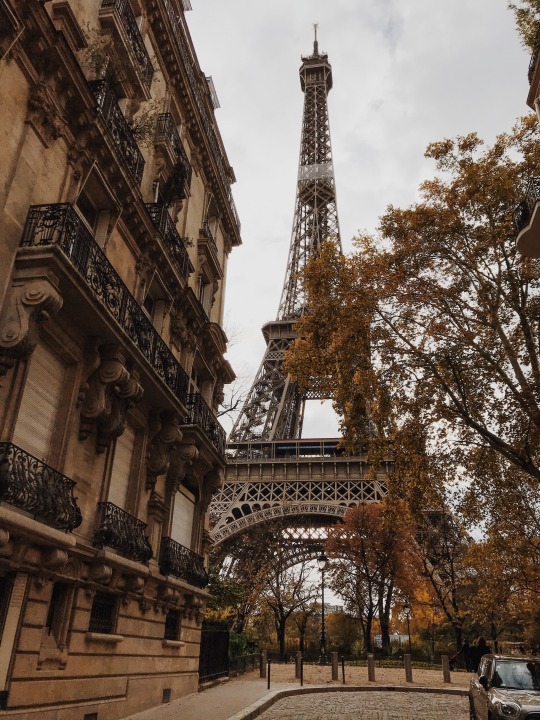
Alright lets start with planning. I searched for EVER to find affordable flights. Typically out of California round trip tickets to Paris are around $1200 each. By some miracle I was able to find round trip tickets for $500 each. (Because it’s off season for tourism and once the weather gets colder, the ticket prices drop) I didn't use any specific sites or cheap airlines, I was just always looking for a deal. So I definitely recommend going on off season (Fall to early spring) to avoid high ticket prices.
While you're planning, I would also really recommend staying at an Airbnb over a hotel. We really felt like we got the true Parisian experience and most Airbnbs are cheaper then hotels is what I noticed while planning.
HERE IS A LINK to the cute private apartment we stayed at while we were there. It was PERFECT for what we wanted. The iconic Parisian windows, a great view to a little courtyard, in the city center, and 3 minute walk to the subway. (Photo below for the ideal Parisian windows I was talking about.)
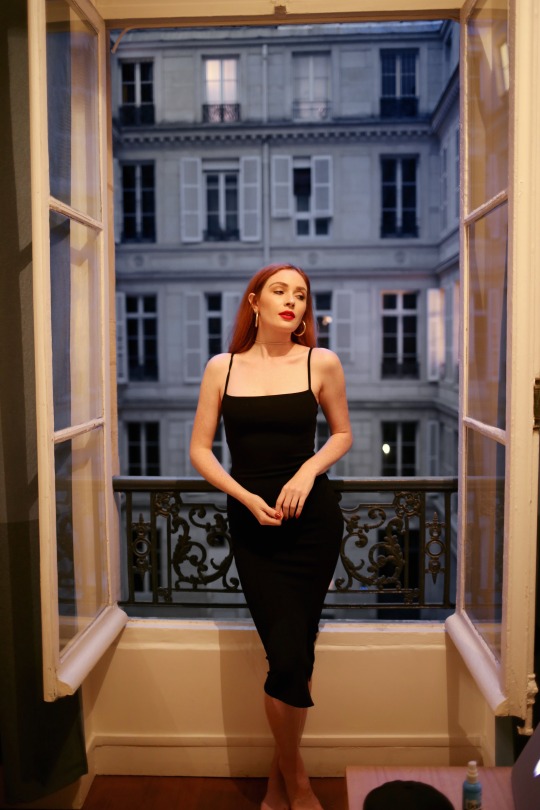
We decided to break up our trip by spending the majority of our time in Paris at the Airbnb, and then the last 2 nights we splurged and stayed at a hotel I’ve had my eye on for awhile now. Hotel Providence is the Parisian hotel of my dreams, and it did not disappoint. The stunning lush decor and rich color palette of the entire hotel checked off all my aesthetic points. We had champagne waiting for us in our room, and they were accommodating for early check in and leaving our bags at the front desk after we checked out, since we had some time to kill before our flight. I found the hotel on Instagram and I’m so glad I did. They have an amazing bar downstairs that was great for pre and post dinner drinks. They serve food as well but we unfortunately never got to try any. The front desk and service at the bar was amazing, super friendly, spoke great English and would absolutely recommend staying here if your budget allows. See below for pictures of our beautiful room and the outside seats of the bar / restaurant! CLICK HERE FOR A LINK TO THE HOTEL
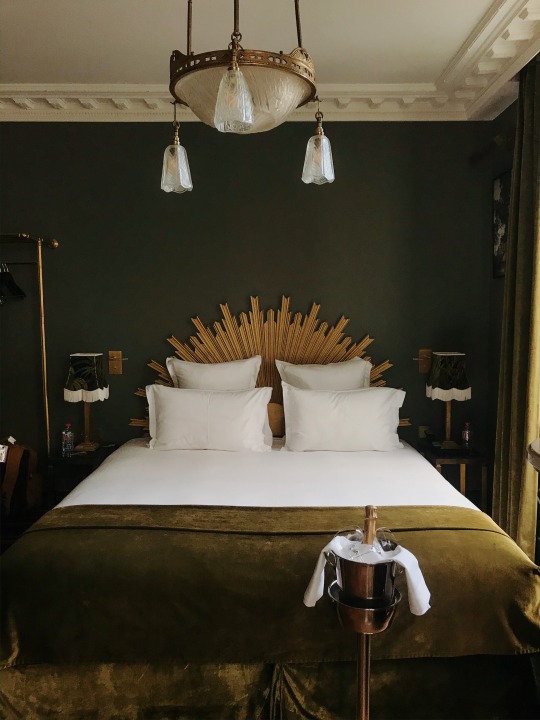

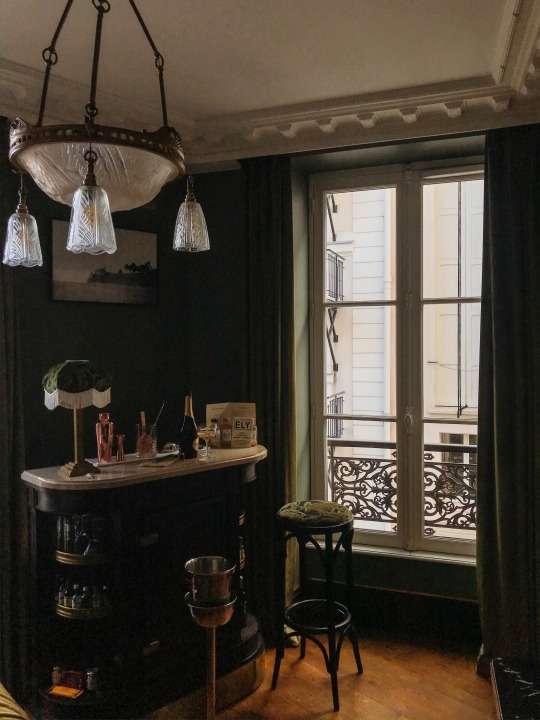
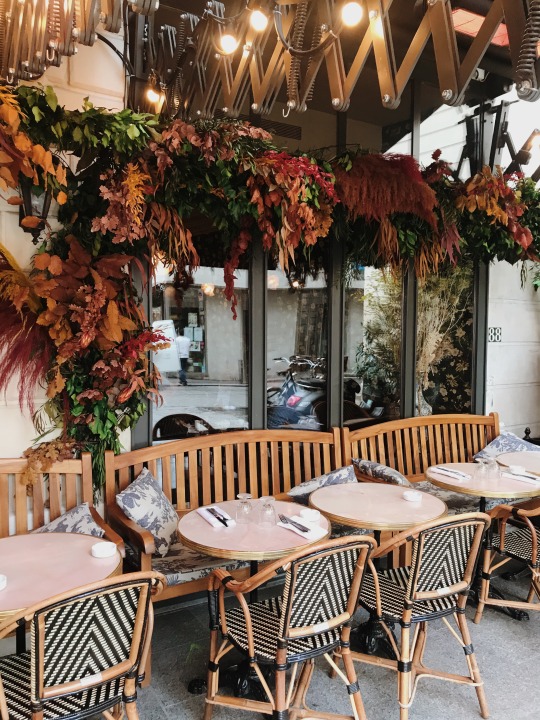
Another thing I would highly recommend is getting the PARIS CITY PASS. This pass will get you into the Louvre, Musee d’Orsay, Versailles, you name a Parisian attraction, and this pass will most likely get you in, and the best part is you won't have to wait in ticket lines. At the Louvre, there was a 2 hour wait to get tickets, and we literally walked RIGHT in... Sorry everyone in line! Should have done your research!
CLICK HERE TO GO TO THE SITE TO GET YOUR PARIS CITY PASS
While planning, something else to think about is transportation. Basically the entire trip, we took Paris’s subway system ‘Le Metro.’ If you have an iPhone, using apple maps is going to be your best friend. Switch your directions to transit instead of walking or driving. The apple maps directions will tell you exactly where to go for the train stations, which lines to take, and which direction you need to be heading. There are signs in English in the subway so don't worry about not being able to understand French signs. There are trains right at the airport, and everywhere you will want to go in the city. Its truly amazing and so affordable compared to trying to Uber everywhere. We honestly preferred taking the subway way more than taking Ubers, because traffic in the city is.... Intense, and most of our Uber drivers didn't speak any English. The trains were always much faster and just easier in general.
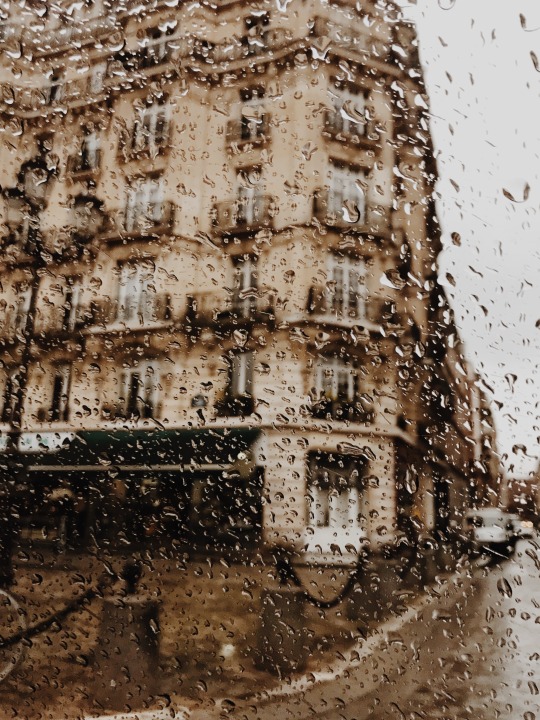
Now I want to share the things we did that were noteworthy, and that we would recommend to anyone who is coming to Paris for the first time.
1. Eiffel Tower. Just as magical as you would think it would be. Head to the Tracadero across the river Seine to get an amazing view and its a GREAT picture spot. Another amazing picture spot is on the same side of the river as the Eiffel Tower and its a little dead end street with the perfect view of the tower with some French buildings in the line of view as well.
Heres the address: 228 Rue de l’Universite (the picture below was taken HERE)

2. Versailles. The grandest palace in all of Europe. It is breath taking. Especially if you're a history nerd like me. I got an audio guide so we didn't have to take a tour, and it was perfect. Also highly recommend renting a golf cart to get around the gardens and to see the other buildings and Marie Antoinette’s little village she created. PICTURE SPOTS: Hall of mirrors, Petite Trianon, and the Grand Trianon. Advice for getting pictures here, PATIENCE. Just wait for people to move so you can get cool shots with no one in them.
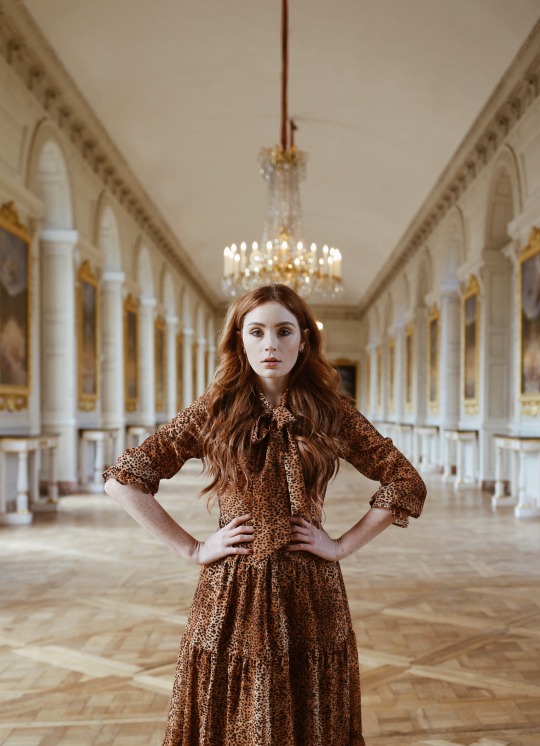
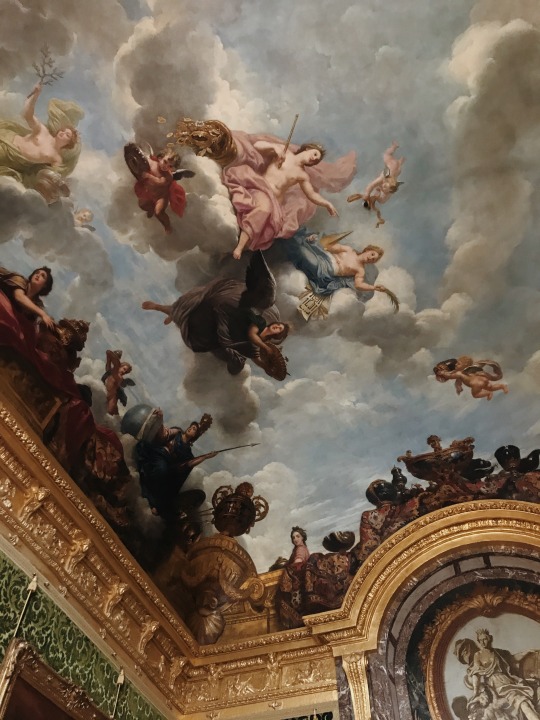

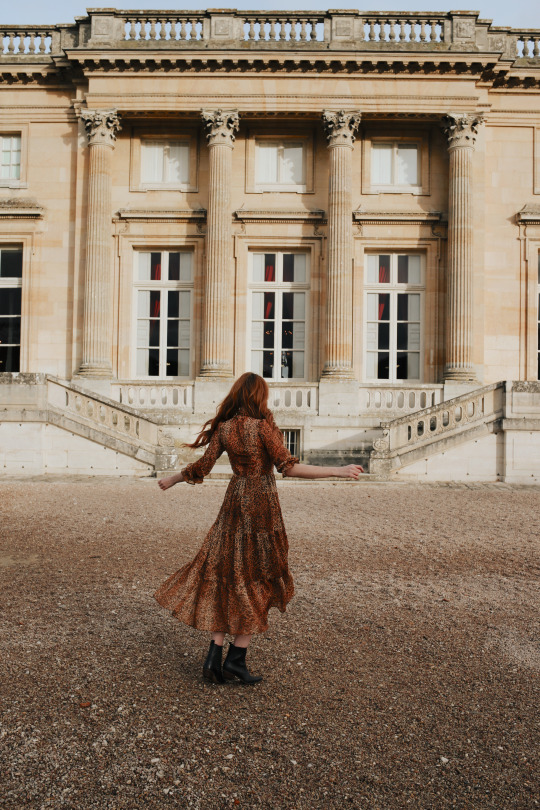
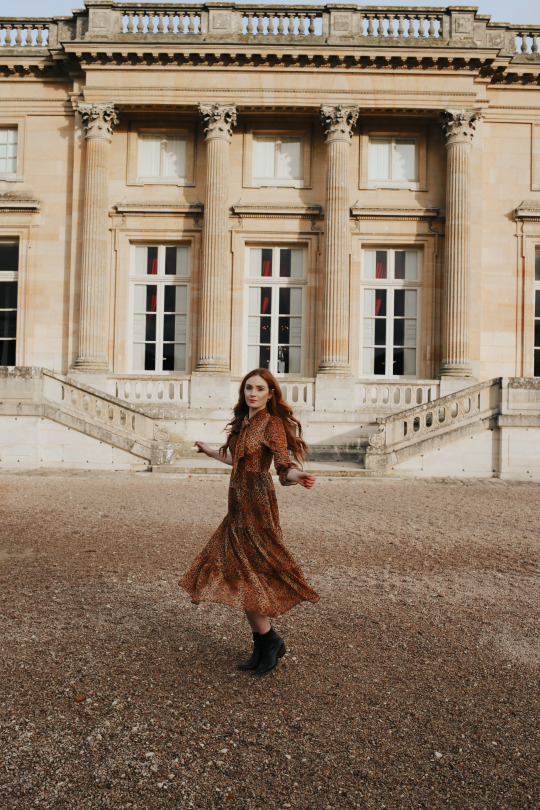
3. Crazy Horse. Ok this one won't be for everyone, but when I think of Paris I think of burlesque. Crazy Horse was one of the coolest burlesque shows we’ve seen and its a must if you're wanting a sexy night out. ( We preferred this over Moulin Rouge. )
4. MontMarte. MontMarte is the cities highest point. resting on a hill, there's a gorgeous old church, the Sacre Couer. MontMarte is also the cities historic artist district. Artists such as Van Gogh, and Renoir, found inspiration in this quaint part of town. Behind the church is the cutest little area where local artists are still paining city scapes and personal portraits. Seeing this area was a highlight for me. It felt so like what I thought Paris would be like. Good rooftop bar with the view of the city and the Eiffel Tower: Terrass Hotel, the rooftop bar is open to the public, you don't have to be staying at the hotel.

5. Le Marais. This is where you need to go if you're wanting to shop. Clothes, local pastries, apothecaries, you name it this area has it. Our favorite stores were Blue Garage, System Vintage, Luka Luna,
6. Notre Dame. A Paris staple. Currently closed for renovations but still worth seeing from afar. The streets around the Notre Dame are covered with vintage magazine / book stands. They make for great home decor. Make sure you have euros pulled out though because they don't accept credit cards!
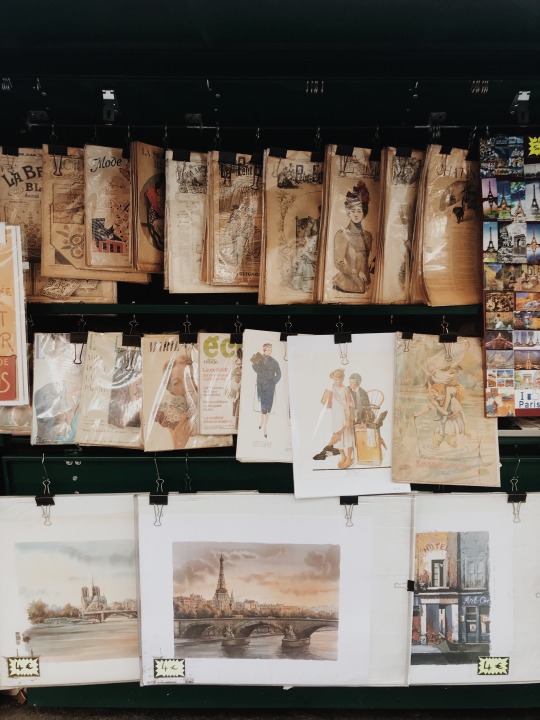

7. Musee d’Orsay. Paris’s second biggest and most famous museum. Is in an old train station which makes for a cool setting for a museum. (See picture below) We liked this museum more than the Louvre...Way less crowded, and more modern artists that we actually knew. Holds famous paintings from Monet, Degas, Renoir, and Van Gogh. Highly recommend grabbing a drink on the 5th floor cafe behind one of the old clocks!

8. The Catacombs. Super interesting walk through some of Paris’s old Limestone quarries that they filled with bones from the cemeteries, when the cemeteries were getting too crowded in the 1700′s. I didn't get any spooky vibes. Just felt like a museum.
9. Palais Garnier. The Opera house in Paris. Reminiscent of Versailles, this grand Opera house is soooo extravagant and gorgeous. The first real Ballets were put on here. How cool is that?
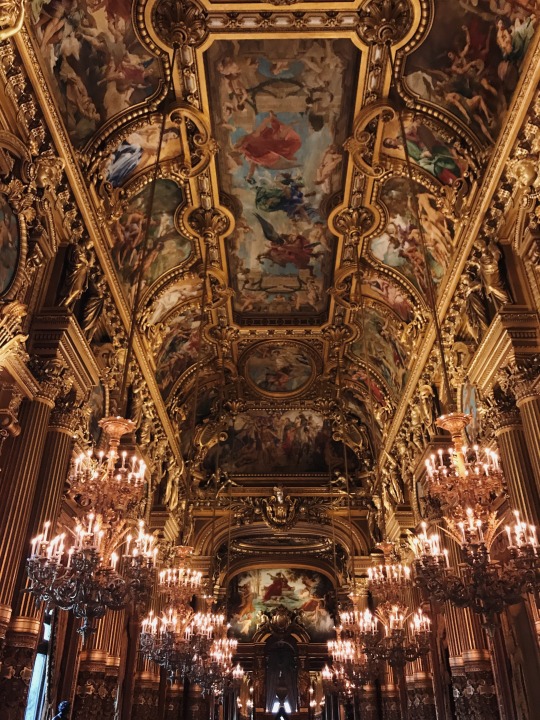
That wraps up the things to see that we loved most. Now lets move on to my favorite part... THE FOOD!
Basically everywhere you look in Paris there are little cafes. Sometimes as many as 4 on a block. Eat at as many of them as you can. They're all pretty incredible. If you're from America and have never traveled to Europe, something to note is that in Europe, slow service is good service. You have to ask for your check. dining out in Europe is an experience and they want you to relax and enjoy your time dining. There is no rush with food there. Its pretty life changing coming from a country where you are accustomed to being in and out of a restaurant within an hour and getting angry if your food hasn't shown up in 15 minutes.
Things you need to try at any Parisian restaurant: bread, butter, wine, and cheese. They're all usually locally sourced and man let me tell you... It just tastes DIFFERENT over there. The butter is the best butter I’ve ever had. When we got home I legitimately looked up where I can buy French butter here in San Diego... The wine? INSANE. One night I had 6 glasses (which is WAY way way too much for me) and the next morning I didn't wake up with any sort of hangover... I don't know what they're doing in France but wow it is amazing. The cheeses are also wonderful. All so different depending on the restaurant, and all taste soooo much fresher then any cheese I’ve had here in the US. It’s hard to describe.
Some of our favorite restaurants we came across while we were there:
BREAKFAST / LUNCH-
Any cafe usually has a Croque Monisuer or a Croque Madame which is basically a grilled cheese sandwich with ham and egg, they're amazing and make a great breakfast sandwich. We also ordered Cafe Au Lait’s everywhere we went for breakfast (Coffee with steamed milk.) And croissants are always a good idea.
La Terrasse Des Archives for an amazing avocado toast eggs Benedict
Hollybelly 5 for some americanized / English style breakfasts and some amazing lattes
Hardware Societie for another amazing Americanized / English breakfast
Breakfast in America is a full on American diner in the heart of Paris.
DINNER-
My favorite meals we ate in Paris were our dinners. There is endless amazing food options but here are some of our favorites.
Sacree Fleur did not disappoint. Located in MontMarte, this cozy restaurant will blow you away. We started with the cheese course, wine, and bread. Had steak and mashed potatoes as our main course, which by the way, continues to cook at your table on a hot slab of rock. SO COOL! And we finished with the creme brûlée, which actually made me CRY, it was so good.... (Terrass Hotel is walking distance away, the rooftop bar is open to the public and you get an amazing view of all of Paris including the Effie tower while enjoying some after dinner drinks, and you don't have to be staying at the hotel to enjoy the rooftop bar.)
Le Petit Italien is an amazing option if you're wanting some Italian food in Paris.
Le Sancrerre in MontMarte was another stand out. I got the beef bourguignon and it was incredible.
Chez Janou was also outstanding. Perfect French dishes, great service. Our waiter was actually living in San Diego for awhile before he moved back home to Paris so it was a super random coincidence to eat there and have him as our waiter!
5 notes
·
View notes
Text
Embarking & Welcome
And suddenly, the day is here-- Paris awaits! How strange it is to wake up and look outside and realize that tomorrow my view will be entirely different. Indiana waves goodbye, while from afar the City of Light mouths, “Bonjour.” As my grandpa would say, “You’ve only got to hop across the pond!” (If only it were that easy. Flight nerves are very real this morning!)
For two weeks, I will be staying in Paris as a part of my senior seminar class at Hope College. Thirteen of us will be embarking on this journey together with our two professors. We will be exploring many of the main sites of Paris, like the Louvre, the Palais Garnier Opera, Saint Chapelle, etc., as a group most days, but we will have considerable free time to experience the city ourselves.

At Hope last week, we intensely studied Paris, Parisian culture, French art, and French history so that we would be able to have this free time, this leisure to explore while in Paris. For what is a trip to Paris without a somewhat leisurely approach? We Americans are always set to go, go, go... (I’ll be fighting this mindset for most of the trip, to be honest-- there’s just SO MUCH to see, yet I must settle and realize that it is impossible to see it all. So I must not try to do the impossible...).
I’m looking forward to seeing Paris in all her glory-- the art, the architecture, the culture, the beauty. My artist heart and dreamer soul will be singing. Yet I’m also seeking to discover the many complexities of Paris, the fissures and imperfections that sometimes do not meet the eye amidst the displayed elegance and drama of the city.
To “meet a place” is to consider all viewpoints, characteristics, and traits within it, through experience and acute observation. This is what I aim to do while I am in Paris. Assertions about the city and Parisian culture I will try to refrain from; rather, I want Paris to take me by the hand and show me around. In quiet reverie I will try to begin to understand this place and culture so different yet innately linked to my own human experience.
I hope you join me in this journey! Follow along for all things Paris-- in this little corner of the internet I’ll be writing about my experience, observations, French art and history, French culture, and so much more. I can’t wait to be in Paris, and I can’t wait to share what I learn and see with you! (Now for the flight-- yippee.)
Welcome to the Paris Collective, friends!
#paris#parisian#paris2019#parisstories#hopecollege#parismayterm#hopecollegeparis#france#french#parisfrance#travel#travelblog#french culture#hopecollegetravel#europe#parisienne
5 notes
·
View notes